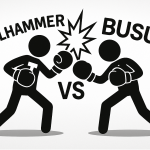Scandinavian languages – Swedish, Norwegian, Danish and Icelandic – attract learners for many reasons. Swedish opens doors to a vibrant culture of music and literature, Norwegian gives access to both Bokmål and Nynorsk traditions, and Danish connects you to Copenhagen’s design-driven world. Yet, these languages also pose challenges. Danish pronunciation is famously difficult because the spelling doesn’t always match the sound. Verb-second word order (V2) can confuse beginners, and definite suffixes work differently than in most European languages. This article compares the best language learning apps in 2025 – Taalhammer, Duolingo, Babbel, Memrise, Lingvist, and Anki – to help you decide which is the best app to learn Swedish, Norwegian, Danish or Icelandic depending on your goals.
- How We Compared the Apps: Taalhammer vs Duolingo, Babbel, Memrise, Lingvist and Anki
- Scandinavian Language Learning App Costs Compared
- Which Language Learning App Is Best for Swedish, Norwegian, Danish and Icelandic?
- FAQ: Learning Scandinavian Languages with Language Learning Apps
- What is the best language learning app for Scandinavian languages?
- Which language learning app helps most with Danish pronunciation?
- Can I use one language learning app to study both Swedish and Norwegian?
- Which language learning app is best for grammar in Scandinavian languages?
- Can Taalhammer help advanced learners of Swedish, Norwegian, or Danish?
How We Compared the Apps: Taalhammer vs Duolingo, Babbel, Memrise, Lingvist and Anki
We evaluated each Scandinavian language learning app using six criteria:
- Grammar support – Does the app explain Scandinavian-specific grammar like V2 word order?
- Pronunciation & listening – How well does it handle difficult sounds, especially Danish?
- Sentence-based practice & input authenticity – Does it teach full sentences or isolated words?
- Cognitive science – Does it use spaced repetition, active recall, and motivation loops?
- Customization – Can learners tailor content to Swedish, Norwegian, or Danish goals?
- Price & value – Free vs. paid options for Scandinavian languages.
First of all let’s see which Scandinavian languages are offered by the apps:
| Swedish | Norwegian | Danish | Icelandic | |
|---|---|---|---|---|
| Taalhammer | yes | yes | yes | yes |
| Duolingo | yes | yes | yes | NO |
| Babbel | yes | yes | yes | NO |
| Memrise | yes | yes | yes | yes |
| Lingvist | yes | yes | yes | NO |
| Anki | yes | yes | yes | yes |
As you can see, while all apps in this comparison offer Swedish, Norwegian and Danish, only Taalhammer, Memrise and Anki offer Icelandic.
Taalhammer – Best for Full-Sentence Learning
Taalhammer positions itself as the best language learning app for serious learners of Scandinavian languages. Unlike apps that focus on isolated words, Taalhammer’s method revolves around sentence-based spaced repetition, helping learners internalize verb-second word order and definite suffixes naturally.
For even more insight into how Taalhammer champions full-sentence learning over other platforms, see the detailed comparison in Taalhammer vs 11 Other Language Learning Apps: Which One Actually Lets You Learn in Full Sentences?
One of Taalhammer’s key strengths is its coverage of all four Scandinavian languages – Swedish, Norwegian, Danish, and Icelandic (in total there are 75 languages accessible). Learners can access countless thematic collections on every CEFR level, ranging from travel and everyday conversations to literature and work-related vocabulary. These collections are diverse, engaging, and designed to make grammar and vocabulary stick in context.
For pronunciation, the app integrates IPA transcription and TTS audio, invaluable for mastering tricky Danish vowels and Swedish tones. Beyond the ready-made content, you can also create your own collections, importing authentic sentences from books, dialogues, or even work materials. This personalization ensures you learn the language that matters most to your goals.
Pros: Covers all four Scandinavian languages, countless thematic collections at all CEFR levels, customizable, strong grammar support, deep retention.
Cons: Less gamified, requires self-motivation.
Duolingo – For Casual Daily Habit
Duolingo is often the first stop for learners thanks to its free language learning app model. It offers Swedish, Norwegian (Bokmål), and Danish in a gamified Path with streaks and rewards that help build daily habits. Guidebooks provide short grammar notes, and speech recognition is included, though it can miss the nuances of Scandinavian pronunciation.
Where Duolingo falls short is in depth and customization. It doesn’t offer advanced thematic content or much control over what you study. Learners looking to master verb-second word order or subtle differences in Danish pronunciation won’t find the detailed support that Taalhammer provides.
Pros: Free tier, strong gamification, great for beginners.
Cons: Limited grammar depth, no advanced CEFR-aligned content, little personalization.
Babbel – For Structured Beginners
Babbel is one of the few apps with CEFR-aligned courses in Swedish, Norwegian, and Danish, covering levels A1 to B1. It offers grammar notes, dialogues, and native audio, making it ideal for learners who want structure and a classroom-like progression.
However, Babbel does not extend far beyond intermediate level, so learners aiming at higher CEFR stages will eventually outgrow it. While it gives a structured path, it doesn’t have countless collections across all CEFR levels or the ability to personalize learning to your own texts, which Taalhammer provides.
Pros: Clear structure, strong beginner grammar support, scenario-based dialogues.
Cons: Stops around B1, less flexible, subscription required.
Memrise – For Authentic Native Input
Memrise shines with its “Learn with Locals” videos, where native speakers show natural Swedish, Norwegian, or Danish phrases. Its AI chat (MemBot) and spaced repetition make vocabulary memorable and practice fun.
Yet, Memrise focuses more on surface-level phrases than deep grammar or structure. Learners won’t find systematic coverage of V2 word order or suffixes, nor the wide variety of thematic collections available in Taalhammer. While it adds authenticity, it lacks the long-term progression system serious learners need.
Pros: Authentic input, fun design, native videos, AI chat.
Cons: Light grammar coverage, limited customization, weaker for advanced learners.
Lingvist – For Fast Vocabulary Growth
Lingvist uses AI and frequency lists to teach the most common Scandinavian words first. Learners get fill-in-the-blank sentences and can even upload texts to generate personalized decks, which makes it highly efficient for vocabulary expansion.
But Lingvist is narrowly focused. It doesn’t provide in-depth grammar explanations or extensive cultural context, which are crucial for real fluency. Learners wanting to move beyond words into complex sentences and CEFR-level progression will need a more comprehensive system like Taalhammer.
Pros: Efficient vocabulary learning, clean UI, customizable decks.
Cons: Minimal grammar, little cultural content, not designed for long-term progression.
Anki – For Power Users
Anki is a highly flexible, open-source flashcard system powered by spaced repetition. Advanced learners can build their own decks with authentic Scandinavian sentences, IPA, and audio, making it one of the most customizable tools available.
The trade-off is steep: Anki has no ready-made Scandinavian courses, no thematic CEFR collections, and requires significant setup. For beginners or casual learners, it can be overwhelming. Where Taalhammer offers ready-to-use structured content plus customization, Anki leaves everything up to the user.
Pros: Maximum flexibility, free desktop version, advanced SRS.
Cons: Steep learning curve, no official Scandinavian content, DIY-only.
Looking for a superior alternative to Anki? Explore our comparison: The Best Anki Alternative for Modern Students to see why Taalhammer offers more than flashcards.
Scandinavian Language Learning App Costs Compared
Pricing among language learning apps for Scandinavian languages varies widely. Duolingo is free but offers limited depth and little control over your learning path. Babbel and Lingvist sit around €6-13/month and €9.99/month respectively, providing structured lessons but mostly up to intermediate level. Memrise offers both free and premium tiers, but grammar and long-term progression are lighter. Anki is free on desktop but requires a paid mobile app, and all setup is left to the user.
Taalhammer, at €9.90/month or €59/year, clearly offers the best value. While it’s not free, it gives you far more than any other app: full-sentence learning, IPA and TTS for pronunciation, all four Scandinavian languages (Swedish, Norwegian, Danish, and Icelandic), and countless thematic collections across every CEFR level. On top of that, you can create your own collections, ensuring that learning always matches your goals.
The investment also matters for motivation: paying for Taalhammer means you’re more likely to stay committed, and unlike free apps, it rewards that effort with long-term retention and measurable fluency progress. In short, it makes sense to pay for Taalhammer because it delivers more than all the free alternatives combined.
For a compelling breakdown of why Taalhammer offers unmatched value even compared to free tools, check out “The Most Affordable Language Learning Apps (That Are Actually Worth It): Taalhammer vs Duolingo and 5 More.”
Which Language Learning App Is Best for Swedish, Norwegian, Danish and Icelandic?
When it comes to learning Swedish, Norwegian, Danish or Icelandic with an app, each tool has its niche – but Taalhammer is the best all-round choice. Its sentence-based fluency training and customizable collections make it especially effective for mastering Scandinavian grammar challenges like verb-second word order and definite suffixes, while also tackling tricky Danish pronunciation with IPA and TTS support. Unlike other platforms, it combines deep retention with flexibility, so you can shape learning around your own goals.
Other apps serve complementary roles:
- Duolingo is useful for casual learners and absolute beginners who want a gamified introduction.
- Babbel provides a structured start aligned to CEFR levels.
- Memrise brings in authentic native video input and fun practice.
- Lingvist is efficient for rapid vocabulary growth.
- Anki remains a powerhouse for advanced learners who want full control through custom decks.
Still, if you’re serious about achieving long-term fluency in Scandinavian languages, Taalhammer offers the strongest combination of science-based learning and authentic content personalization.
The right app depends on your learning style – but for Swedish, Norwegian, Danish and Icelandic fluency, Taalhammer stands out for long-term results.
If Swedish or Norwegian are on your radar, don’t miss our follow-up guides — “Best App to Learn Swedish in 2025” and “Best Language Learning App for Norwegian in 2025.”
FAQ: Learning Scandinavian Languages with Language Learning Apps
What is the best language learning app for Scandinavian languages?
The best all-round choice is Taalhammer, thanks to its sentence-based fluency method and customizable collections that make Swedish, Norwegian, and Danish easier to master. Other apps like Duolingo or Babbel can complement it, but Taalhammer is most effective for long-term results.
Which language learning app helps most with Danish pronunciation?
Danish pronunciation can be tough. Taalhammer addresses this directly with IPA transcription and TTS audio, giving precise control over sound. Memrise is also helpful with its “Learn with Locals” videos, but Taalhammer’s systematic approach ensures deeper retention.
Can I use one language learning app to study both Swedish and Norwegian?
Yes. With Taalhammer, you can customize your collections and study multiple Scandinavian languages at once without overwhelming overlap. Duolingo and Lingvist also offer both, but their linear structure makes switching harder.
Which language learning app is best for grammar in Scandinavian languages?
Taalhammer teaches grammar naturally through full sentences and active recall, which helps with tricky Scandinavian rules like verb-second word order. Babbel explains grammar explicitly, but it lacks Taalhammer’s long-term memory focus.
Can Taalhammer help advanced learners of Swedish, Norwegian, or Danish?
Yes. Unlike apps aimed mostly at beginners, Taalhammer scales to advanced levels because you can import your own texts, generate AI-based examples, and keep expanding your sentence collections. Advanced learners often combine Taalhammer with Anki, but Taalhammer is more user-friendly and ready out of the box.








